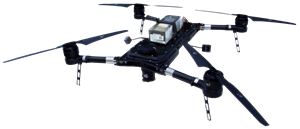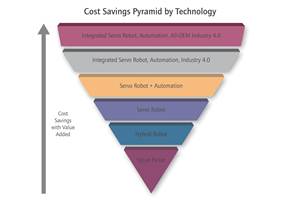Trend to Watch: Making Robots Safer Around People—Without Sacrificing Performance
The five levels of Man-Robot Collaboration (MRC) and what they mean for higher speeds/greater payloads for cobots.
Share
Read Next
So-called “collaborative” robots, or “cobots,” have captured the imagination of a number of plastics processors who are looking for automation that can operate safely in close proximity to human workers and doesn’t have to be locked away behind “hard” guarding. However, these cobots are often compared unfavorably with standard robots in terms of significantly lower speed and payload capacity.
From what I’ve seen at recent trade shows, a potentially significant trend to keep an eye on is suppliers of conventional robots making their units “collaborative”—i.e., safe—without sacrificing high speed and load-carrying capacity (see previous reports here, here, and here). One supplier that recently showed off this capability at April’s Automate show in Chicago is Staubli North America, Duncan. S.C. At the show, Staubli showed off its new TX2 six-axis articulated robots (which also were featured at K 2016 in Dusseldorf). In an interview, Sebastien Schmitt, Robotics Div. Manager, explained to me the significance of this new robot series in terms of five levels of Man-Robot Collaboration (MRC):
• MRC-1 is the standard robot setup, inside a cage so that it can operate at high speed with no possibility of contacting a human.
• MRC-2 (human contact not desired but possible) and MRC-3 (human contact expected) eliminate guarding but use electronic sensors such as laser scanners to sense when a human approaches. Two safety zones are defined: If a human enters one zone of proximity, the robot slows to a relatively safe speed, so the human can easily avoid it. If a human enters an even closer zone of proximity, the robot comes to a complete stop. What’s unique about this setup is that as soon as the human moves away from the robot, it immediately resumes first slow motion on its programmed path, and then full speed. No reset command is required.
• MRC-4 is force-limited operation of the robot, so that it can run fast but stop immediately upon contact without harming the human—or itself if it strikes a hard obstacle, like a forklift. This functionality can be enhanced by covering the robot with a touch-sensitive skin to help it stop on contact.
• MRC-5 is the highest level of collaboration, in which a human manually guides the robot arm to achieve precise positioning of the end-of-arm tooling—perhaps in a hard-to-reach area and/or when the object being handled is heavy or cumbersome. The robot thereby acts as an extension of, or assistant to, the human, but with no limitation in payload capacity.
Schmitt said that the innovation in Staubli’s TX2 series robots is that they can be programmed to operate in all five MRC levels. Schmitt called the TX2 “the world’s fastest safe robot.” He noted that these robots come with a new CS9 safety control have a “separate safe digital encoder” for each axis and an “integrated safety board.” The series has six models that handle loads from 2 to 15 kg with a reach of 515 to 1450 mm. To ensure maximum safety, every motion is monitored by sensors and all position coordinates of the robot arm, as well as its speed and acceleration, are recorded in real time.

Related Content
50 Years of Headlines … Almost
I was lucky to get an early look at many of the past half-century’s exciting developments in plastics. Here’s a selection.
Read MoreDrones and Injection Molding Ready for Takeoff
Drones and unmanned aerial vehicles (UAV) are approaching an inflection point where their production volumes — and functionality — will increasingly point to injection molding.
Read MoreAutomation in Thermoforming on the Rise
Equipment suppliers’ latest innovations exemplify this trend driven by factors such as labor shortages, higher-speed thermoformers and tighter quality control.
Read MoreAutomation Evolution: From Robots to Work Cells, Solo Devices to Integrated Systems
Injection molding automation has progressed from devices to systems, from simplicity to more complex capabilities. The author traces this development through various levels of automation – all still available choices today – and analyzes the costs and capabilities for each level.
Read MoreRead Next
Why (and What) You Need to Dry
Other than polyolefins, almost every other polymer exhibits some level of polarity and therefore can absorb a certain amount of moisture from the atmosphere. Here’s a look at some of these materials, and what needs to be done to dry them.
Read More











.png;maxWidth=300;quality=90)










